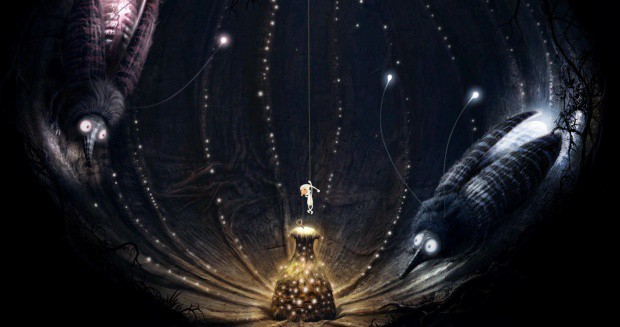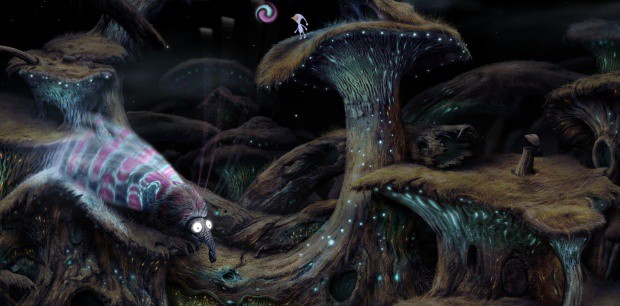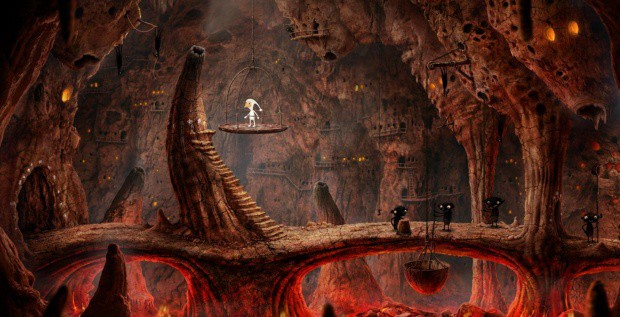Wot I Think: Samorost 3
Organismic
From the team most famous for Machinarium, Aminita Design, comes the third game in the Samorost series. Don't worry if you've never heard of the first two - they were both tiny Flash games. Samorost 3 [official site] is a full-length, full-screen adventure that requires no prior knowledge. How does the adventure/puzzle game hold up at this scale? Here's wot I think:
Samorost is where it all began for Amanita Design, and this return to the series, following their huge raise in reputation and awareness with Machinarium and Botanicula, is a stunning labour of love. Phenomenally beautiful, exquisitely animated, and constantly delightful and joyous, this is a lovely thing. But it’s also the hardest game they’ve made so far, and I’m not sure that’s always for the best.
Samorost 1 is a ten minute web game that introduced the main character, a little chap in a white onesy and dangly bobble hat – apparently only ever known as “Gnome” - who lives on a small organic/metallic island floating in space. By Samorost 2, things lasted closer to half an hour, and the art, animation and music had improved by considerable degrees (although the closing puzzle was a disaster). Samorost 3 makes both look like doodles.
It is without question one of the most beautiful games I’ve ever seen, maintaining that collage look of machinery and nature, photography (I think) and wonderfully rendered artwork, with cartoon characters within. However, this time out the main character, his dog, and a few other peculiar creatures, are more carefully designed. They're textured and detailed in a way that makes them less awkwardly different from the world. But the real magic happens when you meet the game’s animals, flora and strange bearded denizens, who are the most astonishingly wonderfully animated creatures. Each scene is alive with detail, hidden extras to discover, and esoteric puzzles to solve by interacting with everything you can find.
At the start, a horn descends from the sky outside our friend’s house. When he picks it up he discovers that it can be used to listen to specific objects and animals. Some of these noises are mad burbling fun, but others are little tunes that Gnome can play back (thankfully automatically – despite the hefty musical focus, there’s no core puzzle that requires playing back tunes) on the horn, causing animated thought bubbles to appear giving you hints about what you need to do, or initiating events in the scene. Via the horn you learn of a terrible series of events that occurred on other floating worlds nearby, where some sort of guardian person went rogue and began using a terrifying three-headed metallic monster to destroy local beauty and eat the souls of the land. That’s my interpretation of the wordless animations at least. So best put that right.
Gnome begins his journey by working out a new way to get off his home land (the red rocket was destroyed in Samorost 2, of course), which involves a perplexing series of puzzles gathering various items, then building a ship out of an enormous inflatable mushroom thing, and various bits and bobs stripped from the surroundings. Once that opening sequence is complete, you can land on any other islands within your current orbit – a simple mechanical restriction that prevents your flying off to the end of the game at the start.
Each new land is a sumptuous bounty. New creatures, new sounds, new puzzles, and perhaps most significantly in this game, new music to hear. Amanita have always used Tomáš “Floex” Dvořák for their games, and he’s never been short of amazing, but this time his work is on another level. The soundtrack is core to the way you play, so many puzzles rely on crafting songs by clicking on characters, building harmonies, or hearing music on completion. And none of them requires any musical ability on your part.
There is a sequence in which a smattering of maggoty-termite creatures are trotting back and forth across a series of logs. It becomes apparent that you can interact with them, turn them around, even trip them up. Or, if you wait until they’re stood on their back legs, have them start singing. A song so beautiful it moistened my eyes. Click on more of them and they sing in chorus. It’s a throwaway puzzle, an achievement-thing is the only reward, and it was so completely wonderful. I sat there and just listened, completely enchanted. And that really captures the atmosphere and effort of so much of Samorost 3. I’ve written this review with the closing tune looping throughout, and am not sure how I’ll ever manage to switch it off.
But as I said at the start, this is a difficult game, too. Surprisingly so, bearing in mind how accessible Machinarium and Botanicula were. Like Machinarium, there’s an in-built walkthrough so you can’t ever get stuck, but then it also never feels good to get past a challenge that way. I confess I used this a few times throughout, because I was dumfounded as to what the game wanted me to do. Too often it was about returning to areas I thought already finished, or repeating the same action two or three times despite there being no clear indicator this would be necessary. Other times it was poor flagging of puzzles.
One particular puzzle stands out as utterly bemusing to me, where once you’ve gathered a few types of fruit, you’re supposed to guess which location is the place to drop them into a bunch of holes, and then start off on a genetic journey of cross pollinating the flowers they grow to see what new fruits are created, and then further cross-breeding these to try to reach a particular – er – root vegetable. It is by necessity experimental – there’s no way to know what will result – and as a consequence you end up having to retrace your steps to gather the original fruits again and again.
It’s so peculiar that the original fruits aren’t an endless supply, forcing you to re-complete previous puzzles to get them back, and then wildly guessing how to use them. Or opening up the walkthrough (which involves solving a very, very simple ‘puzzle’ – nothing like Machinarium’s daft system) to see solutions for that specific location. These, again, are wordless – pictorial guides that can often be obfuscated by extra details, but will generally get you through.
It’s not fair to tar too much of the game with this. Many puzzles are extremely pleasant to solve, lots of them depending upon fun exploration of what’s possible, making combinations of objects that replenish to see what happens, guessing at where a sequence is heading. Others are straightforward - redirecting pipes, using objects in your inventory, and so on.
One puzzle stands out from the rest, a truly gorgeous challenge that involves placing a series of eight cards in different orders, such that the drawings on each animate in response to the order they’re placed. You’re trying to hunt four different animals for a couple of stickmen, and improvising with the fire, pond, weapons and creatures is absolutely joyful. It’s a shame this device is only used once, early in the game – it would have been welcome to return at any point.
And you can’t stay mad even when bumping against one of the few frustrating sections. Samorost 3 is so bursting with life, so lovingly crafted, that it’s impossible not to adore. I cannot think of a game whose soundtrack comes close to this, and few that are so pretty. Gnome’s yelps of delight, or enthusiastic dances, or the way he sometimes says, “Hop!” when he jumps, are idiotically adorable. It’s so alive, so intricate, and so graceful.
I wonder if the difficulty will see it be a less celebrated game than the last two, but it really is a thing of beauty.
Samorost 3 is out today on Windows and Mac.














